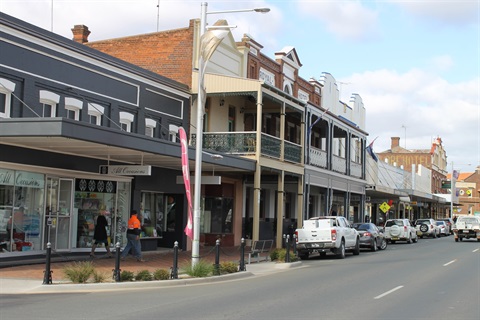West Wyalong

Gold was discovered at Wyalong in September 1893 by Joseph Neeld. In 1895 West Wyalong was developed 5 kilometres from Wyalong around the bullock track, without the benefit of town planning, resulting in curious kinks in the road where it avoided trees and buildings. As well as the mines, the White Tank water supply was located here. This is now the location of McCann Park. The goldfield was declared the most productive in the colony in 1899.
As mining declined, West Wyalong became the main service centre for agriculture in the surrounding district, although for many years there was rivalry between the towns. Both towns wanted the Temora railway line, but settled on a compromise of a station midway between the two towns, called Wyalong Central.
Development since the 1970s has expanded Wyalong in the direction of West Wyalong with several motels built at Central Wyalong. A shared bicycle and pedestrian track was constructed in 1994 to link Wyalong with West Wyalong.
In 2013, the community of Bland joined Dull, Perthshire, Scotland and Boring, Oregon, USA as part of the "League of Extraordinary Communities" now known as Bland, Dull and Boring.
Where does the name ‘Bland’ come from?
It seems there was a calamity in the Regan family that led Mrs William Regan to take up a station on an area known as The Levels. Her husband having prospered on a station at Grabben Gullen decided to sell and take up the large station on The Levels.
Before making the change, he paid a visit to his brother in Van Diemans Land. Returning to Sydney, he caught a cold, which turned to pneumonia, and he died. Mrs Regan was determined to carry on her husband’s plans and she took up the station, naming it The Bland, after a Doctor Bland who lived in Sydney, and who was Mrs Regan’s medical advisor.
From then on the whole district became known as The Bland.
William Bland (1789-1868) formerly a naval surgeon, was convicted of murder (as manslaughter) and transported to Tasmania with a sentence of seven years reaching Hobart in January 1814 and Sydney on 14 July 1814 where he served at Castle Hill for a short period of time. He received a pardon in January 1815, and became the first full-time private practitioner in New South Wales.
He was a prominent figure in the early political and medical life of the colony. Bland continued in active medical practice until 1868 and died intestate in Sydney on 21 July 1868 of pneumonia.
- Reproduced with courtesy of the State Library of NSW and Wyalong Museum